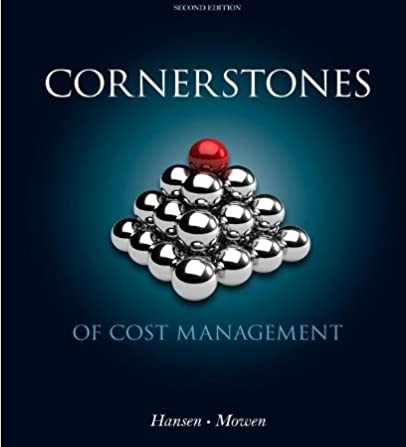
Cornerstones of Cost Management 2nd Edition by Don Hansen ,Maryanne Mowen
Edition 2ISBN: 978-1111824402
Cornerstones of Cost Management 2nd Edition by Don Hansen ,Maryanne Mowen
Edition 2ISBN: 978-1111824402 Exercise 53
Impact of Inventory Changes on Absorption-Costing Income: Divisional Profitability
Dana Baird was manager of a new Medical Supplies Division. She had just finished her second year and had been visiting with the company's vice president of operations. In the first year, the operating income for the division had shown a substantial increase over the prior year. Her second year saw an even greater increase. The vice president was extremely pleased and promised Dana a $5,000 bonus if the division showed a similar increase in profits for the upcoming year. Dana was elated. She was completely confident that the goal could be met. Sales contracts were already well ahead of last year's performance, and she knew that there would be no increases in costs.
At the end of the third year, Dana received the following data regarding operations for the first three years:


Upon examining the operating data, Dana was pleased. Sales had increased by 20 percent over the previous year, and costs had remained stable. However, when she saw the yearly income statements, she was dismayed and perplexed. Instead of seeing a significant increase in income for the third year, she saw a small decrease. Surely, the Accounting Department had made an error.
Required:
1. Explain to Dana why she lost her $5,000 bonus.
2. Prepare variable-costing income statements for each of the three years. Reconcile the differences between the absorption-costing and variable-costing incomes.
3. If you were the vice president of Dana's company, which income statement (variable-costing or absorption-costing) would you prefer to use for evaluating Dana's performance? Why?
Dana Baird was manager of a new Medical Supplies Division. She had just finished her second year and had been visiting with the company's vice president of operations. In the first year, the operating income for the division had shown a substantial increase over the prior year. Her second year saw an even greater increase. The vice president was extremely pleased and promised Dana a $5,000 bonus if the division showed a similar increase in profits for the upcoming year. Dana was elated. She was completely confident that the goal could be met. Sales contracts were already well ahead of last year's performance, and she knew that there would be no increases in costs.
At the end of the third year, Dana received the following data regarding operations for the first three years:


Upon examining the operating data, Dana was pleased. Sales had increased by 20 percent over the previous year, and costs had remained stable. However, when she saw the yearly income statements, she was dismayed and perplexed. Instead of seeing a significant increase in income for the third year, she saw a small decrease. Surely, the Accounting Department had made an error.
Required:
1. Explain to Dana why she lost her $5,000 bonus.
2. Prepare variable-costing income statements for each of the three years. Reconcile the differences between the absorption-costing and variable-costing incomes.
3. If you were the vice president of Dana's company, which income statement (variable-costing or absorption-costing) would you prefer to use for evaluating Dana's performance? Why?
Explanation
1)Identify the reason for lost $5,000 bo...
Cornerstones of Cost Management 2nd Edition by Don Hansen ,Maryanne Mowen
Why don’t you like this exercise?
Other Minimum 8 character and maximum 255 character
Character 255


